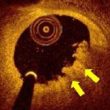The authors have given an entertaining account of the most relevant points and differences between the new STEMI guidelines and the prior ones, from 2014. The article features 10 points resembling the ten commandments, which makes it easy to read, compared to the tedious task of reading the complete guidelines. 1) The emergency systems should help...
OCT Follow-Up of Plaque Erosion with Medical Therapy and Without Stenting
Most acute coronary syndromes (ACS) are caused by the following three different pathologies: Plaque rupture Plaque erosion Calcified nodule In daily clinical practice, all patients who experience them are treated with angioplasty, regardless of which of these physiopathologies led to the ACS in each case. Some early reports indicate that patients with plaque erosion might...
FOURIER: Evolocumab Found Beneficial for Patients with Peripheral Vascular Disease of Prior MI
Patients with peripheral vascular disease or prior acute myocardial infarction (especially within the first two years after the event) could find a particular benefit the PCSK9 receptor inhibitor evolocumab. Given its high cost, the drug is not yet cost/effective and when prescribed, most patients were no table to complete the treatment. Read also: “Missed Opportunities with...
FOURIER: Efficacy of Evolocumab for Ultra-Low LDL Levels
It seems that a LDL level of 70 mg/dL is no longer low enough for high-risk secondary patients; in consequence, this study attempted to set a new target, one that appears almost impossible to reach: 40 mg/dL or lower. This study, simultaneously presented at the European Society of Cardiology Congress 2017 and published in The Lancet, showed...
Statin Pre-Treatment for the Prevention of Peri-Procedural Events in Carotid Artery Stenting
Recent randomized studies have shown that the rates of combined peri-procedural events for carotid artery stenting and carotid endarterectomy are similar. While the final numbers are similar, the actual events are different: more infarction events for endarterectomy and more stroke (particularly minor stroke) events for carotid artery stenting. The reduction of these rates of stroke has been the aim of...
The transradial approach reduces the risk of kidney injury in acute patients
It remains unclear whether transradial access, compared with transfemoral access, presents a different risk of post-procedural kidney injury for patients admitted with acute coronary syndrome. Historically, it has been considered (without any evidence) that, given the higher difficulty associated with transradial access, it would require longer fluoroscopy time and higher contrast volume, which would eventually...
Early Endarterectomy Seems Superior to Carotid Stenting in Symptomatic Patients
Patients with symptomatic stenosis of the internal carotid artery benefit from early intervention. The challenge lies in what intervention to choose. Most studies comparing endarterectomy to carotid stenting are fairly heterogeneous as regards timing of intervention. This element is key to comparing between procedures, since there is no doubt timing will directly affect results. ...
Missed Opportunities with Patients with Peripheral Vascular Disease
Little is known about how good are our counseling efforts on medication use and lifestyle as regards patients with peripheral vascular disease. More often than not, we use our time with these patients to discuss the technical feasibility of rechanneling, or to analyze the risk of eventual amputation. However, how often do we seize the...
When to Indicate Statin Therapy
The use of non-invasive imaging can identify or rule out subclinical atheromatosis and help reduce the number of elderly patients unnecessarily treated with statins without increasing the risk of cardiovascular events. Using calcium score and carotid ECG to find elderly patients without atheromatosis helps to safely avoid the use of statins with no clinical...
HOPE 3: Reducing LDL Improves Prognosis in Intermediate Risk Patients
In a large cohort of intermediate risk patients with no known CAD, treatment with low doses of statins in addition to an angiotensin receptor blocker and a diuretic, reduce the risk of cardiovascular events, compared to placebo. These are the main findings of the HOPE 3 trial (Heart Outcomes Prevention Evaluation) that randomized 12705 patients,...









